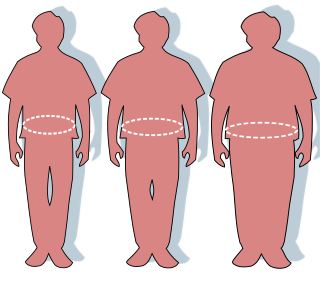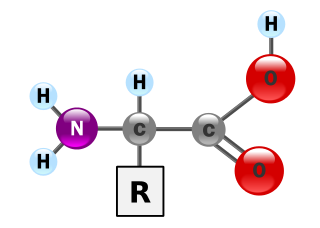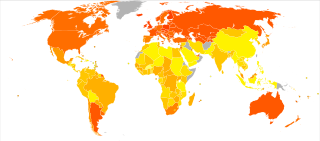Related Research Articles

Obesity is a medical condition, sometimes considered a disease, in which excess body fat has accumulated to such an extent that it can potentially have negative effects on health. People are classified as obese when their body mass index (BMI)—a person's weight divided by the square of the person's height—is over 30 kg/m2; the range 25–30 kg/m2 is defined as overweight. Some East Asian countries use lower values to calculate obesity. Obesity is a major cause of disability and is correlated with various diseases and conditions, particularly cardiovascular diseases, type 2 diabetes, obstructive sleep apnea, certain types of cancer, and osteoarthritis.
An essential amino acid, or indispensable amino acid, is an amino acid that cannot be synthesized from scratch by the organism fast enough to supply its demand, and must therefore come from the diet. Of the 21 amino acids common to all life forms, the nine amino acids humans cannot synthesize are valine, isoleucine, leucine, methionine, phenylalanine, tryptophan, threonine, histidine, and lysine.
Human body weight is a person's mass or weight.
Basal metabolic rate (BMR) is the rate of energy expenditure per unit time by endothermic animals at rest. It is reported in energy units per unit time ranging from watt (joule/second) to ml O2/min or joule per hour per kg body mass J/(h·kg). Proper measurement requires a strict set of criteria to be met. These criteria include being in a physically and psychologically undisturbed state and being in a thermally neutral environment while in the post-absorptive state (i.e., not actively digesting food). In bradymetabolic animals, such as fish and reptiles, the equivalent term standard metabolic rate (SMR) applies. It follows the same criteria as BMR, but requires the documentation of the temperature at which the metabolic rate was measured. This makes BMR a variant of standard metabolic rate measurement that excludes the temperature data, a practice that has led to problems in defining "standard" rates of metabolism for many mammals.

A healthy diet is a diet that maintains or improves overall health. A healthy diet provides the body with essential nutrition: fluid, macronutrients such as protein, micronutrients such as vitamins, and adequate fibre and food energy.
Resting metabolic rate (RMR) is whole-body mammal metabolism during a time period of strict and steady resting conditions that are defined by a combination of assumptions of physiological homeostasis and biological equilibrium. RMR differs from basal metabolic rate (BMR) because BMR measurements must meet total physiological equilibrium whereas RMR conditions of measurement can be altered and defined by the contextual limitations. Therefore, BMR is measured in the elusive "perfect" steady state, whereas RMR measurement is more accessible and thus, represents most, if not all measurements or estimates of daily energy expenditure.
The body fat percentage of an organism is the total mass of its fat divided by its total body mass, multiplied by 100; body fat includes essential body fat and storage body fat. Essential body fat is necessary to maintain life and reproductive functions. The percentage of essential body fat for women is greater than that for men, due to the demands of childbearing and other hormonal functions. Storage body fat consists of fat accumulation in adipose tissue, part of which protects internal organs in the chest and abdomen. A number of methods are available for determining body fat percentage, such as measurement with calipers or through the use of bioelectrical impedance analysis.
Energy consumption is the amount of energy used.
Biological value (BV) is a measure of the proportion of absorbed protein from a food which becomes incorporated into the proteins of the organism's body. It captures how readily the digested protein can be used in protein synthesis in the cells of the organism. Proteins are the major source of nitrogen in food. BV assumes protein is the only source of nitrogen and measures the amount of nitrogen ingested in relation to the amount which is subsequently excreted. The remainder must have been incorporated into the proteins of the organisms body. A ratio of nitrogen incorporated into the body over nitrogen absorbed gives a measure of protein "usability" – the BV.

Proteins are essential nutrients for the human body. They are one of the building blocks of body tissue and can also serve as a fuel source. As a fuel, proteins provide as much energy density as carbohydrates: 17 kJ per gram; in contrast, lipids provide 37 kJ per gram. The most important aspect and defining characteristic of protein from a nutritional standpoint is its amino acid composition.

The physical activity level (PAL) is a way to express a person's daily physical activity as a number and is used to estimate their total energy expenditure. In combination with the basal metabolic rate, it can be used to compute the amount of food energy a person needs to consume to maintain a particular lifestyle.
The Institute of Medicine Equation was published in September 2002. It is the equation which is behind the 2005 Dietary Guidelines for Americans and the new food pyramid, MyPyramid.

Being overweight is having more body fat than is optimally healthy. Being overweight is especially common where food supplies are plentiful and lifestyles are sedentary.
The Harris–Benedict equation is a method used to estimate an individual's basal metabolic rate (BMR).

Diet plays an important role in the genesis of obesity. Personal choices, food advertising, social customs and cultural influences, as well as food availability and pricing all play a role in determining what and how much an individual eats.
In biology, energy homeostasis, or the homeostatic control of energy balance, is a biological process that involves the coordinated homeostatic regulation of food intake and energy expenditure. The human brain, particularly the hypothalamus, plays a central role in regulating energy homeostasis and generating the sense of hunger by integrating a number of biochemical signals that transmit information about energy balance. Fifty percent of the energy from glucose metabolism is immediately converted to heat.

Weight management comprises behaviors, techniques, and physiological processes that contribute to a person's ability to attain and maintain a healthy weight. Most weight management techniques encompass long-term lifestyle strategies that promote healthy eating and daily physical activity. Weight management generally includes tracking weight over time and identifying an individual's ideal body weight.
A caloric deficit is any shortage in the number of calories consumed relative to the number of calories needed for maintenance of current body weight.
Paul Deurenberg is a Dutch retired academic, nutritional biochemist and consultant. He was a former associate professor in the Department of Human Nutrition at Wageningen University (WU), and is most known for his research expertise in the areas of energy metabolism, food consumption, and body composition studies.
Energy expenditure, often estimated as the total daily energy expenditure (TDEE), is the amount of energy burned by the human body.
References
- ↑ Schofield WN (1985). "Predicting basal metabolic rate, new standards and review of previous work". Human Nutrition: Clinical Nutrition. 39 Suppl 1: 5–41. PMID 4044297.
- ↑ World Health Organisation, Fao, and Unu. Energy and protein requirements. Geneva: WHO, Technical Report Series 724, 1985.
- ↑ J Am Diet Assoc. 2009;109:330-346.
- ↑ Energy Requirements of Adults, Report of a Joint FAO/WHO/UNU Expert Consultation, (See table 5.2).
- ↑ "Human energy requirements". www.fao.org. Retrieved 2023-12-25.